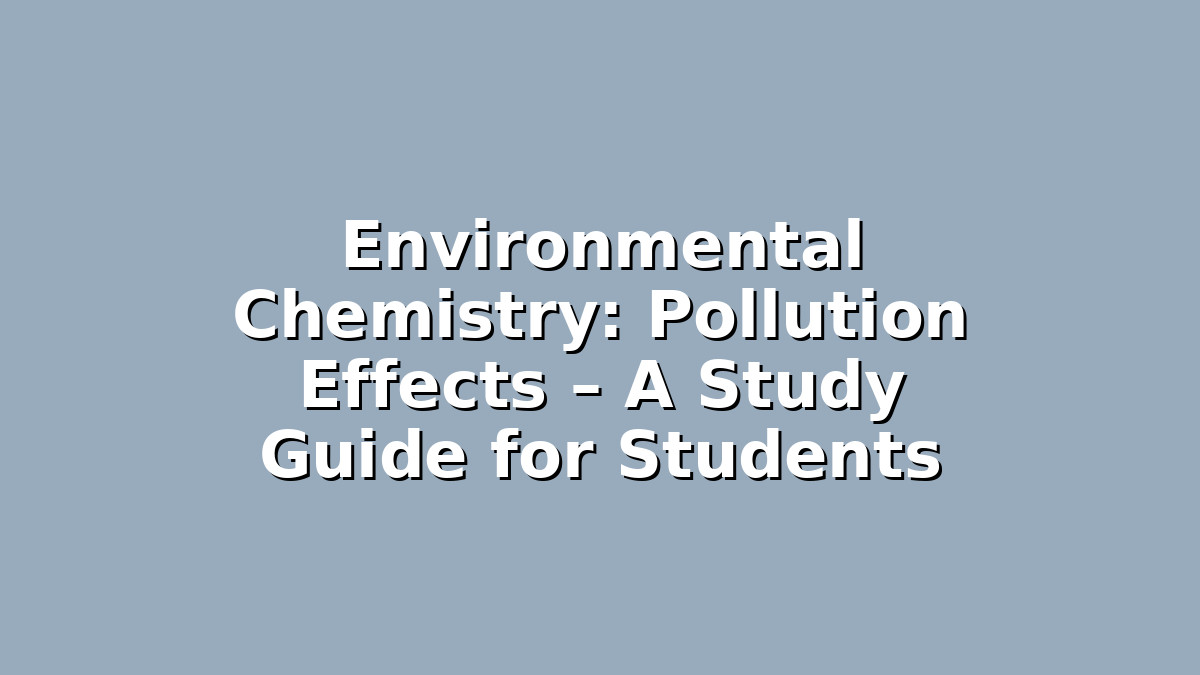Preparing for exams in environmental chemistry can feel overwhelming, especially when topics like pollution effects involve complex scientific concepts and real-world applications. Whether you’re studying for high school finals, college exams, or competitive tests, understanding how pollution impacts the environment is essential. Not only does this knowledge help you score better, but it also raises awareness about critical global issues.
In this article, we’ll explore the key effects of pollution through three focused sections: Air Pollution, Water Pollution, and Soil Pollution. Along the way, you’ll get practical study tips designed to help you retain information and apply it effectively in your exams. Let’s dive in!
1. Air Pollution: Causes, Effects, and Study Tips
Understanding the Topic
Air pollution occurs when harmful substances, such as gases, particulates, and biological molecules, contaminate the atmosphere. Common pollutants include carbon monoxide (CO), sulfur dioxide (SO₂), nitrogen oxides (NOx), particulate matter (PM), and volatile organic compounds (VOCs). These pollutants primarily come from vehicle emissions, industrial processes, burning fossil fuels, and even natural events like wildfires.
The effects of air pollution are wide-ranging. On human health, pollutants can cause respiratory diseases, cardiovascular problems, and aggravate allergies. For the environment, air pollution contributes to problems like acid rain, ozone layer depletion, and global warming.
Study Tips for Air Pollution
– Create Concept Maps: Air pollution involves various pollutants and their effects. Use concept maps to visually connect sources, pollutants, and consequences. This helps in making logical links and understanding cause-effect relationships that are commonly tested.
– Use Real-World Examples: Remember examples like the Great Smog of London or acid rain in industrial areas. These case studies make the information memorable and help you apply theory to practical situations in exams.
– Practice with Diagrams: Many exams require you to explain processes such as photochemical smog formation or the greenhouse effect. Practice drawing and labeling diagrams to clarify these mechanisms quickly during tests.
—
2. Water Pollution: Types, Impact, and Effective Revision Strategies
Understanding the Topic
Water pollution occurs when harmful substances contaminate water bodies like rivers, lakes, oceans, and groundwater. This can result from industrial discharge, sewage, agricultural runoff, oil spills, and plastic waste. Pollutants include heavy metals (like mercury and lead), nitrates, phosphates, pathogens, and microplastics.
The effects of water pollution are detrimental to aquatic life, human health, and ecosystems. Contaminated water can lead to diseases such as cholera and dysentery in humans, while also causing eutrophication — an excessive growth of algae that depletes oxygen in water, killing fish and other aquatic organisms.
Study Tips for Water Pollution
– Summarize Key Pollutants: Make tables categorizing pollutants by source, chemical nature, and effects. This organized format makes revision smoother and helps in quick recall.
– Watch Educational Videos: Visual learning can enhance understanding. Look for animated videos explaining processes like eutrophication or the water treatment cycle to reinforce concepts.
– Do Practice Questions: Find previous exam questions or online quizzes about water pollution. This helps familiarize you with question styles and improves your ability to write concise, focused answers.
—
3. Soil Pollution: Causes, Consequences, and Memorization Techniques
Understanding the Topic
Soil pollution results from the presence of toxic chemicals or waste in the soil. Major contributors include pesticides, industrial waste, heavy metals, and improper disposal of household waste. Soil contamination affects plant growth, reduces soil fertility, and can introduce harmful substances into the food chain.
The consequences extend beyond agriculture. Polluted soil can lead to bioaccumulation of toxins in animals and humans, disrupt ecosystems, and contribute to groundwater contamination.
Study Tips for Soil Pollution
– Use Mnemonics: Develop mnemonics to remember the main causes and effects of soil pollution. For example, “PISH” can stand for Pesticides, Industrial waste, Sewage, and Household waste.
– Relate to Everyday Life: Think about how soil pollution might affect local farming or gardening. Making personal connections to the topic enhances retention.
– Teach Someone Else: Explaining soil pollution concepts to a peer or family member can reinforce your own understanding and highlight any gaps in knowledge.
—
Conclusion
Environmental chemistry and pollution effects are critical topics that not only appear frequently in exams but also hold global significance. By breaking down pollution into air, water, and soil categories, you can approach your studies systematically. Use practical tools like concept maps, tables, videos, and mnemonics to make your revision more effective and engaging.
Remember, consistent practice and connecting concepts to real-life scenarios are key strategies that will help you excel in your exams. Stay curious, keep practicing, and believe in your ability to master this important subject!
Good luck with your studies!

Responses